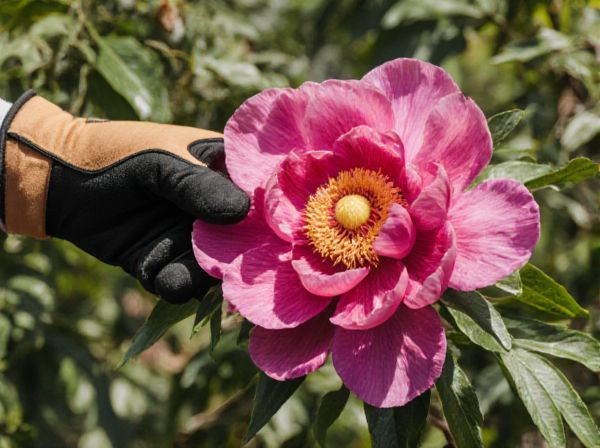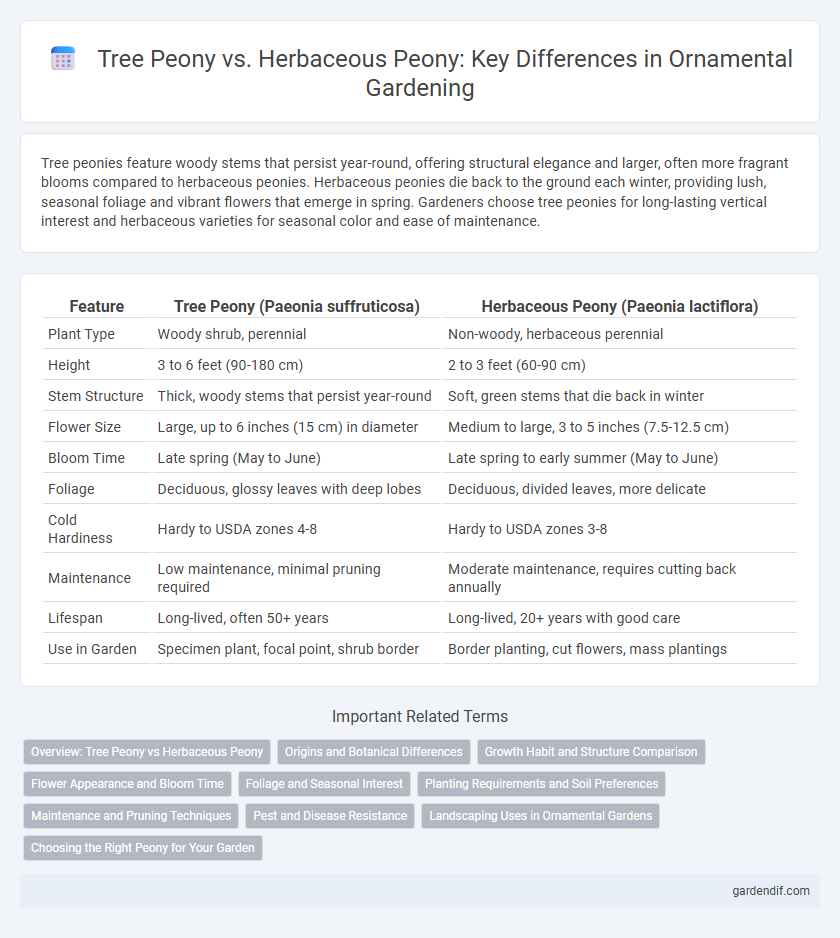
Tree Peony vs Herbaceous Peony Illustration
Tree peonies feature woody stems that persist year-round, offering structural elegance and larger, often more fragrant blooms compared to herbaceous peonies. Herbaceous peonies die back to the ground each winter, providing lush, seasonal foliage and vibrant flowers that emerge in spring. Gardeners choose tree peonies for long-lasting vertical interest and herbaceous varieties for seasonal color and ease of maintenance.
Table of Comparison
| Feature | Tree Peony (Paeonia suffruticosa) | Herbaceous Peony (Paeonia lactiflora) |
|---|---|---|
| Plant Type | Woody shrub, perennial | Non-woody, herbaceous perennial |
| Height | 3 to 6 feet (90-180 cm) | 2 to 3 feet (60-90 cm) |
| Stem Structure | Thick, woody stems that persist year-round | Soft, green stems that die back in winter |
| Flower Size | Large, up to 6 inches (15 cm) in diameter | Medium to large, 3 to 5 inches (7.5-12.5 cm) |
| Bloom Time | Late spring (May to June) | Late spring to early summer (May to June) |
| Foliage | Deciduous, glossy leaves with deep lobes | Deciduous, divided leaves, more delicate |
| Cold Hardiness | Hardy to USDA zones 4-8 | Hardy to USDA zones 3-8 |
| Maintenance | Low maintenance, minimal pruning required | Moderate maintenance, requires cutting back annually |
| Lifespan | Long-lived, often 50+ years | Long-lived, 20+ years with good care |
| Use in Garden | Specimen plant, focal point, shrub border | Border planting, cut flowers, mass plantings |
Overview: Tree Peony vs Herbaceous Peony
Tree peonies (Paeonia suffruticosa) are woody shrubs with large, fragrant flowers and a long blooming season, offering a dramatic architectural presence in gardens. Herbaceous peonies (Paeonia lactiflora) die back to the ground each winter, producing vibrant, often double blooms that provide seasonal color and adaptability to various climates. Both types contribute unique ornamental value, with tree peonies favored for their structural form and herbaceous peonies prized for their lush, seasonal displays.
Origins and Botanical Differences
Tree peonies (Paeonia suffruticosa) originate from China and are characterized by their woody stems that survive year-round, distinguishing them from herbaceous peonies (Paeonia lactiflora), which die back to the ground annually. Botanically, tree peonies produce larger, often more fragrant flowers with more complex petal structures, while herbaceous peonies tend to have a wider range of flower colors and bloom later in the season. The genetic differences between the woody shrub form and the herbaceous form result in distinct growth habits, with tree peonies requiring less staking due to their sturdy branches.
Growth Habit and Structure Comparison
Tree peonies exhibit a woody, shrub-like growth habit with rigid stems that can reach up to 4-6 feet in height, creating a sturdy, long-lasting structure ideal for garden focal points. Herbaceous peonies, in contrast, possess soft, non-woody stems that die back to the ground annually, growing to about 2-3 feet tall and regenerating each spring. The structural difference impacts maintenance and garden design, with tree peonies offering year-round architectural interest and herbaceous peonies providing seasonal bloom cycles.
Flower Appearance and Bloom Time
Tree peonies feature large, robust flowers with a papery texture and bloom in mid to late spring, offering a dramatic floral display. Herbaceous peonies produce softer petals with a more delicate appearance and bloom earlier in late spring to early summer. The distinct flower forms and staggered bloom times allow gardeners to select peonies that suit specific ornamental purposes and seasonal interest.
Foliage and Seasonal Interest
Tree peonies feature woody stems with large, deeply lobed dark green foliage that offers a striking architectural element throughout the growing season. Herbaceous peonies display lush, bright green, finely divided leaves that emerge fresh each spring and turn reddish or bronze in fall, providing multi-seasonal interest. Both types contribute vibrant foliage textures that enhance garden aesthetics beyond their blooming periods.
Planting Requirements and Soil Preferences
Tree peonies require well-drained, fertile soil with a slightly alkaline pH of 7.0 to 7.5, thriving best in partial shade to protect their woody stems from harsh sun. Herbaceous peonies prefer rich, loamy soil with good drainage and a neutral to slightly acidic pH around 6.5 to 7.0, flourishing in full sun for optimal flowering. Both types benefit from deep planting to establish strong roots, but tree peonies demand more protection from wind and extreme moisture fluctuations to prevent damage.
Maintenance and Pruning Techniques
Tree peonies require less frequent pruning, primarily removing dead wood and shaping in early spring, while herbaceous peonies demand annual cutting back to the ground after foliage dies in late fall to prevent disease. Maintenance for tree peonies involves limited watering and mulching to protect woody stems, whereas herbaceous varieties need consistent moisture during growing seasons and well-drained soil conditions. Both types benefit from nutrient-rich compost application in early spring to promote vigorous growth and abundant flowering.
Pest and Disease Resistance
Tree peonies exhibit greater resistance to common pests such as aphids and thrips compared to herbaceous peonies, reducing the need for frequent insecticide treatments. They are less susceptible to fungal diseases like botrytis blight and powdery mildew, which often affect herbaceous peony foliage and stems. Selecting tree peonies can lead to healthier plants with fewer chemical interventions in ornamental garden landscapes.
Landscaping Uses in Ornamental Gardens
Tree peonies provide a bold, sculptural presence with their woody stems and large, fragrant blooms, making them ideal focal points in ornamental garden landscapes. Herbaceous peonies, with their lush foliage and vibrant flowers that die back annually, offer versatile border plantings and massing effects for dynamic seasonal interest. Both types thrive in well-drained soil and full sun, allowing landscapers to incorporate diverse textures and bloom times for enhanced garden aesthetics.
Choosing the Right Peony for Your Garden
Tree peonies offer large, fragrant blooms and sturdy woody stems, making them ideal for gardeners seeking a long-lasting, architectural focal point. Herbaceous peonies provide vibrant seasonal color with softer, bushy growth that dies back in winter, perfect for adding seasonal interest and versatility. Selecting between tree and herbaceous peonies depends on your garden's climate, space, and maintenance preferences to ensure optimal growth and flowering.
Tree Peony vs Herbaceous Peony Infographic

 gardendif.com
gardendif.com